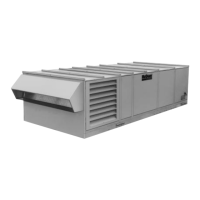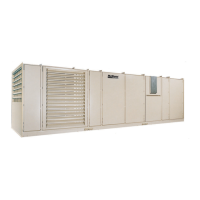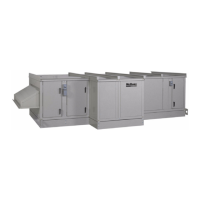McQuay IM 987 17
Mechanical Installation
Roof Curb Assembly and Installation
Locate the roof curb and unit on a portion of the roof that can
support the weight of the unit. The unit must be supported to
prevent bending or twisting of the machine.
If building construction allows sound and vibration into the
occupied space, locate the unit over a non-critical area. It is
the responsibility of the system designer to make adequate
provisions for noise and vibration in the occupied space.
Install the curb and unit level to allow the condensate drain to
flow properly and allow service access doors to open and close
without binding.
Integral supply and return air duct flanges are provided with
the RAH roof curb, allowing connection of duct work to the
curb before the unit is set. The gasketed top surface of the duct
flanges seals against the unit when it is set on the curb. These
flanges must not support the total weight of the duct work.
Assembly of a typical RAH roof curb is shown in Figure 18,
page 18. Parts A through H are common to all units having
bottom return openings. Depending on the unit length, Parts L
and M may be included with the roof curb kit to create the
correct overall curb length.
Assembly instructions
1 Set curbing parts A through H per dimensions shown
over roof opening or on a level surface (see Figure 18,
page 18). Note location of return and supply air
openings.
2 If applicable, set other curbing parts (D, L, M, etc.) in
place making sure that the orientation complies with the
assembly instructions (see Detail A). Check alignment of
all mating bolt holes.
3 Bolt curbing parts together using fasteners provided.
Tighten all bolts finger tight.
4 Square entire curbing assembly and securely tighten all
bolts.
5 Position curb assembly over roof openings. Curb must be
level from side to side and over its length. Check that top
surface of the curb is flat with no bowing or sagging.
6 Weld curbing in place. Caulk all seams watertight.
Remove backing from 0.25" (6 mm) thick × 1.50"
(38 mm) wide gasketing and apply to surfaces shown by
cross-hatching.
7 Flash curbing into roof as shown in detail view B
(Figure 19).
8 Parts E and F are not required on units with no return
shaft within the curb perimeter.
9 Parts G and H are not required on units with no supply
shaft within the curb perimeter.
10 Be sure that electrical connections are coordinated (see
Figure 26).
WARNING
Mold can cause personal injury. Some materials such as
gypsum wall board can promote mold growth when damp.
Such materials must be protected from moisture that can enter
units during maintenance or normal operation.

